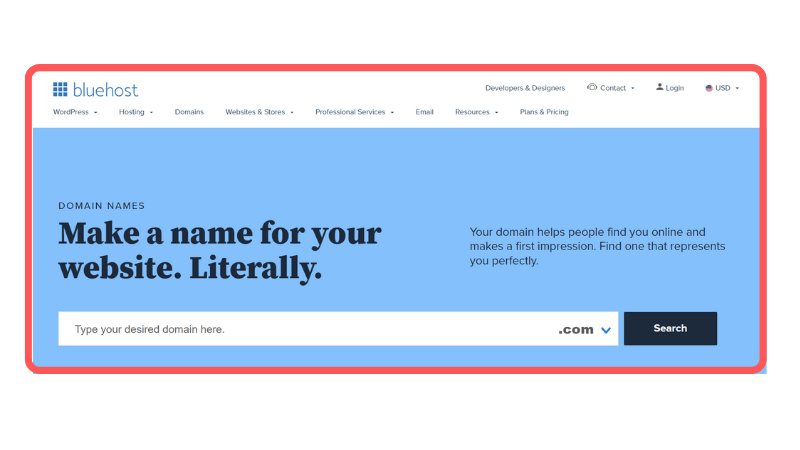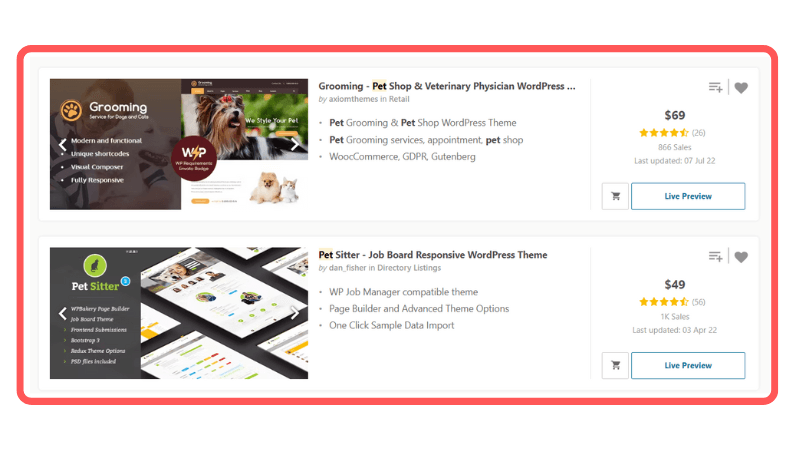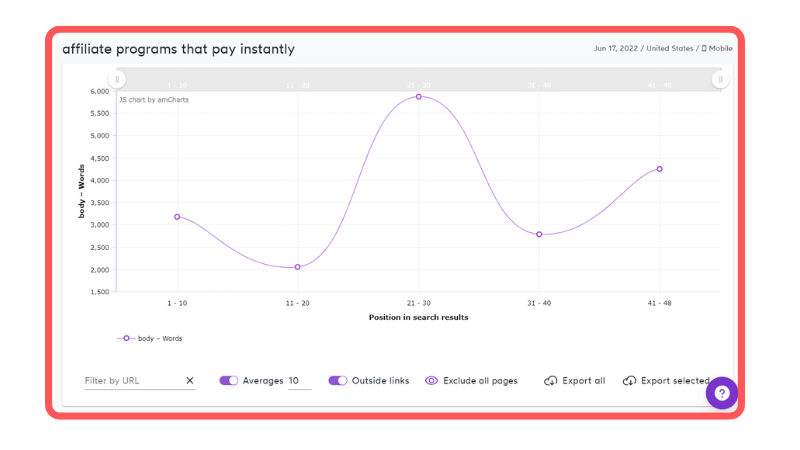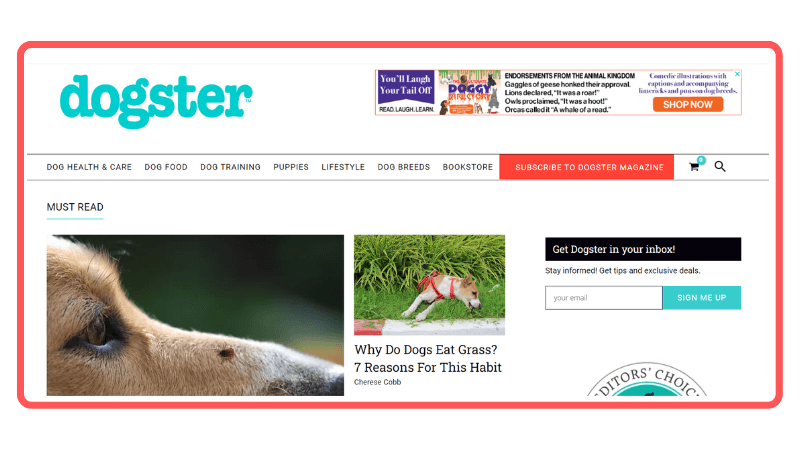
Starting a pet blog can be a fun way to share your love of animals and help other people care for them at the same time. In addition to allowing you to express your passion for cats, dogs, birds, and other pets, blogging about them can also be rewarding from a financial standpoint.
By 2030, global pet care alone (a segment of the pet industry itself) is said to be worth $230 billion. So there’s no denying that it’s a huge market to operate in and certainly, you will (& should) experience competition to thrive in such a space.
When it comes to starting a successful pet blog, requires research, preparation, and persistence. However a blog isn’t something you start on a whim, it’s a long-term commitment that requires time and dedication. But if you have the right attitude, success is within reach.
How To Start a Pet Blog in 7 Steps in 2022?
Firstly I need to mention that pet blogging can be lucrative, but it’s also competitive. There are hundreds, if not thousands, of pet blogs exists online, so you’ll want to do a little research before deciding on how to start your blog.
The research doesn’t have to be complex for pet blogging, as you can follow the same approach of blogging when it comes to pet blogging. However, there can be slight tweaks while running such niche blogs, depending on you and your goals.
So I hope you’re here reading this with an empty cup (empty mind) because what I am going to share could be a perfect starting point for someone trying to get into pet blogging in 2022. For simplification, let’s go over the seven steps to starting a pet blog.
1) Pick your sub-niches
 Blogging about pets is a niche within itself, and you might have thought that your job is done in terms of picking a niche since you have decided to write pet blogs. But it would only help if you didn’t think so.
Blogging about pets is a niche within itself, and you might have thought that your job is done in terms of picking a niche since you have decided to write pet blogs. But it would only help if you didn’t think so.Because there are thousands of blogs that talk about pets and animals. You can Google for any pet information, and you could quickly come across dozens of active blogs talking about it, which should indicate to us that there’s a crowd in this space.
So to stand a chance in such a crowded market (Although not saturated yet), I would highly recommend someone to create a topic and expertise of their own in this pet space. You simply can’t assume to write about every pet under the sun and hope to get away with it because:-
- Writing about everything and anything about pets will build no expertise in the beginning.
- Also, to rank on search engines, you need to build that topical authority (Where you as a blogger have to cover as many topics as possible under one particular topic)
- What about the topics which you are trying to cover were already published by prominent websites in your space and you got very little to no chance to outrank them.
Hence for many more obvious reasons as such, it’s important to research and pick sub-niches for your blog which would fall under one big niche.
The two examples of such best pet blogs I can give are AdoptADog and Walkin’PetsBlog. One talks about adopting rescued dogs and taking care of them, and the other one is a blog about taking the best care for handicapped dogs.
Did you see my point?
Neither of the two blogs that I mentioned doesn’t talk solely about dogs. Instead, they are focused on a sub-niche that they have created for themselves, and as a new pet blogger, I would highly recommend you to start by targetting on such sub-niches.
Assuming you’ve built an established blog talking about pet food or pet health for a specific animal. In the latter, you can pivot into other niches relevant to your current topics, and this way you can grow your pet blog more effectively.
2) Pick a domain name
 Choosing a domain name comes down to what you’ve decided your blog to be, and this can set the direction for your pet blog. For example, this blog called The Minimalistic Vegan clearly indicates that this blog is about minimalism and veganism.
Choosing a domain name comes down to what you’ve decided your blog to be, and this can set the direction for your pet blog. For example, this blog called The Minimalistic Vegan clearly indicates that this blog is about minimalism and veganism.Hence in one way or another, the blog has restricted itself to writing on a particular set of topics. Which you don’t want from your own pet blog too.
Even though in Step 1, I have insisted you choose sub-niches over your actual niche as a whole but when it comes to deciding on how to name a blog, you shouldn’t keep the name too specific because as we blog along with that particular domain name it can become harder to pivot and leverage other sub-niches within your niche.
Also we all should know that the blogging paths can be uncertain. Because there is no sure shot way to know which one topic will bring you traffic as it will depend upon a lot of factors like writing, SEO, readers, etc.
Hence a blog name should be something broad and should help you if you want to pivot. However, I can give some slight tips before coming up with pet blog name ideas:-
- Choose a short blog name (Mostly 2-3 words)
- Add an adjective or verb to the name
- Include a familiar word or phrase in your domain name (Ex’s:- PawNation)
In case you don’t know where to start thinking about it and come up with blog names. Just check this tool which can suggest your 100’s pet blog name ideas.
Note:- Use BlueHost to book your domain name for FREE. This is valid only if you purchase their hosting (Which is affordable)
3) Choose a web host for your pet blog
Web hosting services are the ones which are responsible for storing your blog’s data on the internet. So most of the popular web hosting companies out there will be good enough for you to choose.
However, when starting a blog, choosing a web host should be simple and obvious. But since the market is filled with diversified web hosting companies and as a newbie, you might be overwhelmed by the options on web hosting services.
But being a newbie pet blogger it can all come down to budget when you’re just starting out. Hence, in that case, I recommend you choose BlueHost’s shared web hosting, which costs around $3.95 per month and is probably the most affordable web hosting plan out there.


4) Design your pet blog from scratch (or) Install a WordPress Theme
Designing your blog might not be as crucial as choosing a niche for your blog. But a blog with horrible design and terrible user experience doesn’t let you win in any case; instead, it can tank your pet blogging growth.
However, most bloggers install WordPress and use its FREE themes. That’s a good starting point
In case you know how to design without templates, then you can probably use page builders like Elementor once you install WordPress on your site. Or else you can hire a WordPress designer to design your website from scratch.
If we assume you don’t know how to design on WordPress from scratch and also if you’re tight on a budget to hire a dedicated designer, then the best option is to choose WordPress templates from Envato.

These templates can differ from your usual FREE WordPress templates and might be suitable for the pet blog design that you’re vouching for.
Tip:- Look at other pet blogs in your sub-topics and probably adopt the same design style to make this Step less hassle for you.
5) Plan your content (Target topics for Pet blog)
So you’ve got a domain name and a blog design; now it’s time to give your pet blog some content. Probably this section/step has to be the most important of all, and this is where most newbie bloggers struggle to go wrong by doing keyword research incorrectly and choosing to write blog posts that they can never rank.
I know blogging is freedom, and probably as a writer and someone who loves to talk about pets. You might think that doing keyword research will bound you to your limits in terms of choosing what to write.
But writing articles with no target keywords is just like spilling drinks all over the place. (It’s just going to get messy)
However, there’s another way to look at it, with proper keyword research and planning out your content. You’re more so be stumbling upon topics which you would never think of covering (& who knows, you might even like writing such articles).
Here I can share two effective ways through which you can come up with content ideas for your pet blog, and those will be:-
5aa) Using Ahrefs to find keywords for which the existing blogs in your space are ranking for
Ahrefs is a well-known keyword research tool that can help bloggers find keywords for their blogs through the data it can provide.
 So here, using Ahrefs, I will show you a simple strategy through which you can find dozens of content ideas for your blog.
So here, using Ahrefs, I will show you a simple strategy through which you can find dozens of content ideas for your blog.- Grab at least 3-4 URLs of existing competitor pet blogs in the market and insert each individual URL into the ‘Site Explorer’ of Ahrefs.
- Look at the organic keywords of the site.
- Since you’re starting a new blog, use these filters (KD: 0-50, Traffic Min: 500). Later you can play around with the filters.
- Once you see a list of sorted keywords, search for those which you think will suit your blog and do a quick SERP analysis.
- In the SERP analysis, sort out the keywords which have weaker sites/new sites (i.e., DR 30 below) ranking in the Top 10. It indicates that if such weak websites are ranking in the Top 10 then your pet blog has a good chance of ranking too.

5b) Use Tools Like Google Trends to come up with trending blog topics
The above strategy is really helpful in finding the existing keyword opportunities (from your competitors) but only relying on the existing keywords isn’t enough. What if you can tap into the keywords which are yet to become famous and potentially can generate a good amount of traffic for your pet blog later.
Sensing the potential and upcoming trendy topics can be tricky. However, since you’re in a niche that you love to write about and probably you would have some ideas on what’s getting more popularized lately.
 For example, if we look at the ‘Pet Insurance’ trend in the last five years. We would clearly see that this topic has grown gradually increased and today it’s a lot more saturated than it used to be.
For example, if we look at the ‘Pet Insurance’ trend in the last five years. We would clearly see that this topic has grown gradually increased and today it’s a lot more saturated than it used to be.Similarly, if you could find such topics which are bound to be a trend and are just starting to catch up. Then finding keywords in un-saturated topics using tools like Ahrefs and Google Trends can be fruitful.
6) Write Those Articles (Use tools to 5x your writing)
Once you’ve decided what you want to write about and identified the keywords, it’s time to start writing. To rank on Google and beat your competitor’s articles, as we discussed you just can’t write anything and expect it to rank.
Each article should be written in such a way that it has the chance to outrank the existing top articles for your keyword. There are a lot of factors to consider before you start writing an article which will include:-
- Research
- Good outline
- Writing style
- Reader’s perspective
- Introductions
- Headings and subheadings
- Use of media and much more
Now, this is very subjective to what’s a good article if you ask an individual. But since we rely soo much on data today, why not be we use online tools to help us write the best article that can rank.
6a) Use Sufer SEO for Outline and on-page SEO suggestions
I can’t tell how much time and guesswork this tool can save you when it comes to crafting a perfect article with the best probability to rank on top. Surfer SEO, if you don’t know, is an A. I driven content generation tool that, in this case, it can help you plan, outline, and optimize content for a post.
For any given keyword, this tool analyses the top-ranking articles and will come up with the best suggestions to create an article/outline in terms of,
- Average Word Count (Which tells you how long should a blog post be)
- Exact words and phrases to use in the content (So that Google can easily understand and relate to your content)
- Internal link suggestions & much more

 If you can leverage Sufer SEO in the finest way possible, then most of your on-page SEO optimization is taken care of.
If you can leverage Sufer SEO in the finest way possible, then most of your on-page SEO optimization is taken care of.6b) Use Jasper AI To Write Content
Through Surfer SEO, you should by now have an idea of your outline, if not the outline itself. But how are you gonna go about following the outline and writing the blog post itself?
 This is where Jasper AI, an AI content writing tool, can help you generate the content at a pace without you having to go through any writing blocks.
This is where Jasper AI, an AI content writing tool, can help you generate the content at a pace without you having to go through any writing blocks.Although Jasper is an AI tool, you can’t rely on it all the time to generate content for you. As a blogger, similar to the outline the content within the outline should be according to what you think is the best for your readers. If you are a dog lover who likes writing about them. Then I don’t think the message you’re trying to share with the world can be replicated by a tool.
 Hence, that being said, with the help of Jasper, you can easily 2x your writing speeds without even using the tool to its fullest potential. Although I would hugely disagree if someone told me that one could rely only on such tools to rank on Google. (Because no matter how much AI we use, there needs to be a human interpretation to write the content we want).
Hence, that being said, with the help of Jasper, you can easily 2x your writing speeds without even using the tool to its fullest potential. Although I would hugely disagree if someone told me that one could rely only on such tools to rank on Google. (Because no matter how much AI we use, there needs to be a human interpretation to write the content we want).Therefore take the help of these tools but never blindly go forward with it. Use your own conscience to come up with better content pieces.
The best part about using Jasper AI and Sufer SEO is that you could integrate Surfer SEO into Jasper and start writing content that can be optimized then and there itself. Which is the reason why these two tools stand top in my list of content writing tools for SEO.
Bonus:- You can leverage Jasper AI for free for up to 10k words.
7) Promote your pet blog (Leverage off-page SEO)
In the above step, we have taken care of writing optimized pieces of content, and once you publish a bunch of articles on your website. It comes down to how you build authority to your blog and wait for Google to rank your content.
In terms of promoting your pet blog, there are two ways in which you could leverage:-
- Off-page SEO (To build authority and rank on Google)
- Social media channels (To generate that instant rush of Traffic)
7a) Off-SEO (Building Authority)
You must know that off-page SEO is all about backlinks, and you could quickly get your website in the eyes of Google and other search engines by building backlinks. But keep in mind that your on-page SEO (i.e., blog posts) and content needs to be on-point before you start building backlinks and expect good results.
Here I won’t bore you with suggestions like building profile links, forum links, blog comments, etc., because they don’t work that effectively, and they are a total waste of time if you ask me. Hence what I would recommend is to go after two kinds of backlinks:-
- Guest posts:- Guest posts are nothing but you write content and publish it on another blog in return for a backlink. Since you’re gonna operate in the pet industry, I would recommend you to Google ‘Your Pet Niche’ + ‘Write for Us’ (For example, ‘DOG’ + ‘Write For Us’) to come across websites in your space that accepts guest posts and pitch them for guest posts.
- Editorial Links:- These types of backlinks are nothing but link insertions. Where you request another blog to insert your article link in exchange for money or maybe for free.
Apart from the above two types of backlinks, there are still many backlinking strategies that you can go after, such as broken link building, HARO, and Un claimed brand mentions, etc., to get the links that you want.
7b) Social Media Channels (For Traffic)
Social media is a great promotion channel for bloggers. I am sure people would surely follow and love seeing pet content on social media. However, you won’t be posting your articles there. Instead, you can use pictures of pets and make videos to generate exposure to your social media accounts.
Also, Traffic coming from other platforms can be a good indication for Google to consider your blog and consider its content authoritative. In some cases, it can help you boost your Google rankings too.
On the internet, plenty of bloggers use platforms like Pinterest to bring thousands of Traffic to their websites and convert that traffic into revenue. For example, you can watch this video from Katie Grazer on how she was able to generate traffic to her blog using Pinterest.
Hence you can do the same with your pet blogs once you understand which platform suits you best and if you can leverage it to your full potential.
Usually, social media promotions can include:-
- Growing your account and generating engagement to your posts
- Leveraging other bloggers and influencer’s accounts to promote your content to their audience
- Running ads to your account (Which can be expensive)
Top Pet Blogs To Follow & Know Your Journey
No matter in which niche you operate for blogging and also it doesn’t matter whether you’re into blogging (or) looking to grow your online. To keep up, you have to follow top players in your niche and learn from their websites as a blogger.
The 8 best pet blogs which I am gonna share are indeed an inspiration for the new pet bloggers out there. If you’re about to start a pet blog and looking to stay in this niche for the long term, then I suppose following these top pet blogs and learning their strategies could help you reap some benefits for your blog.
In this section, I will list the top pet blogs I found on Google, which is on the basis of the Traffic that these blogs generate. I choose such blogs because if they rank on Google a lot, then they must’ve built some good authority in the space and more importantly they should be earning good enough.
Unfortunately, there are not many pet bloggers who share their income online. However, after looking at their traffic numbers from Ahrefs, I can estimate that some of these websites are making upwards of $10k per month. I think these are some damn good figures to consider while blogging.
1) Dogster
 Dogster.com is a well-known pet website that has been around for over a decade. It’s a blog that covers all the topics related to dogs in an entertaining way. Precisely they are solely focused on dogs, and they have dozens of ebooks published on dogs talking about everything from dog tricks to dog diet. These ebooks are available on their own website.
Dogster.com is a well-known pet website that has been around for over a decade. It’s a blog that covers all the topics related to dogs in an entertaining way. Precisely they are solely focused on dogs, and they have dozens of ebooks published on dogs talking about everything from dog tricks to dog diet. These ebooks are available on their own website. Indeed Dogster has to be on the top of the list of dog blogs that make money, and the way they’ve monetized their sites with ebooks and magazines should give you an idea (or) two on how you can monetize your own pet blog as dog owners.
Indeed Dogster has to be on the top of the list of dog blogs that make money, and the way they’ve monetized their sites with ebooks and magazines should give you an idea (or) two on how you can monetize your own pet blog as dog owners.2) Catster
 Catster is an excellent cat blog that has been around for over a decade. The story and growth behind Catster started when an award-winning Cat Fancy magazine which started as a voice for all cats back in 1965 by Leslie Slawson Smith and his wife Elizabeth joined in forces with Belvoir Media Group in 2015.
Catster is an excellent cat blog that has been around for over a decade. The story and growth behind Catster started when an award-winning Cat Fancy magazine which started as a voice for all cats back in 1965 by Leslie Slawson Smith and his wife Elizabeth joined in forces with Belvoir Media Group in 2015.Belvoir Media Group runs both the Dogster and Catster blogs. Hence the monetization approach for this cat blog is similar to what we saw for Dogster.
3) HandicappedPets (Walkn’ Pets Blog)
Handicapped Pets is another excellent blog on dogs that makes money. This pet blog has been around for more than a decade as well, and Mark C. Robinson is the person behind starting this blog. In 2001, when he lost his beloved Keeshond and had less knowledge of what had happened.
So he became a certified dog trainer and created this blog to share knowledge on pet health and dogs with special needs, such as those in wheelchairs, blind, and deaf dogs.
Mark had this vision to share as much knowledge as possible on specialized dogs that need care, and over the years, his pet blog has turned into a well-managed organization that serves the purpose of mobilizing dogs in need.
4) My Pet Chicken
My Pet Chicken is an excellent blog about chickens (duh!) started by an ex-vegetarian named Kathy, who decided to get chickens after she realized the benefits of raising backyard chickens. The website is run by Kathy, her husband Jack, and their son Sam, who are all chicken keepers.
My Pet Chicken earns a lot of money through affiliate marketing, selling products ranging from chicken houses to chicken feeders and other chicken-related things (duh!). The readers of this site learn how to care for their chickens easily.
Hence I assume since this pet blog, is not about dogs (or) cats, I think it should inspire people trying to blog about other pets as well.
5) GoFriendlyPet

6) PetKeen
 PetKeen.com is a blog aimed at sharing knowledge on animal psychology and for people passionate about the well-being of animals, big and small. Unlike most pet blogs, this blog is peer-reviewed by a board of practising veterinarians, vet technicians, and animal trainers willing to offer practical and helpful advice backed by research and science.
PetKeen.com is a blog aimed at sharing knowledge on animal psychology and for people passionate about the well-being of animals, big and small. Unlike most pet blogs, this blog is peer-reviewed by a board of practising veterinarians, vet technicians, and animal trainers willing to offer practical and helpful advice backed by research and science.This blog is meant to resolve any questions related to pet gear, pet health, pet food, safety, behaviour, and anything else pet-related. Currently, PetKeen talks extensively about 19 pet animals covering from all small pets to reptiles.
7) The Dogington Post
TheDogingtonPost.com is a blog that talks about dog news, dog product reviews, and dog nutrition. According to Ahrefs, this site generates over 70k views per month and the website is filled with tons of pieces of content.
I guess the number could be even more, and mostly as far as we can see, this blog generates income through sponsored content, ads, and affiliate links.
8) All About Cats
AllAboutCats.com is a blog that talks about cats, their behaviour, their care, and everything related to cats. The content published on this blog is reviewed by vets and cat experts who love to talk about cat care.
According to Ahrefs, this pet blog generates over 700k+ visitors per month, which is astonishing.
I can write more about such dozens of pet blogs that you can look up to. But I think by now, you get the gist that by following the popular blogs in your pet industry, you get to learn a lot by understanding their strategies, and maybe you can replicate some for your own benefit.
5 Ways To Make Money with Pet Blogging
One of the pros of blogging about pets is that you get to make money, and here I am not talking about making just 1-2 thousand dollars per month.
In fact, some of the pet blogs on the internet make up to five figures a month just by leveraging a few of the monetization channels I am about to share with you.
1) Sell your range of pet products
Hundreds of eCommerce businesses sell their own pet merchandise through running paid ads and paid influencer collaborations on social media. They have to spend money because initially, they have no audience for their brand, but what if you’ve grown your website to a few thousand visitors per month and the readers keep coming to it.
If you realize, you will have the leverage that most pet-based eCommerce stores don’t, which is having an existing audience base. Thus once you get your pet blog to that point, it becomes so evident to make sales if you launch your own range of pet products catering to your audience, and thus that becomes a good income stream.
2) Sell pet grooming and pet training courses
Pet care, as we talked about already, is a booming industry, and pet lovers don’t like to hold their pockets when it comes to improving their pet’s overall lifestyle. This is where pet grooming and training courses come to be a lucrative income source for pet bloggers like you.
Providing such courses doesn’t have to be in-person coaching (or) recording videos to teach people how to train their dogs. Similar to Dogstar and Catstar, you can publish ebooks talking about pets to help your readers in the way that they can see an improvement in their relationship with their pets.
Thus that’s one good way to make money with pet blogging as well.
3) Offer pet consultations
Offering pet consultations can’t be done by some random pet blogger who isn’t a vet. But what if you’re already a vet (or) a pet expert?
However, what if you could bring a bunch of vets and pet experts onto your website and bring them, customers, via consultations?
I guess you see the point.
If you look at PetKeen’s website, which I mentioned above, do the same thing. With this, I guess now you have another idea on how to many money with pet blogging.
4) Sell Affiliate Products
We should all know that, Affiliate marketing is the best way to make money through blogging. You get paid for referring other people to purchase a particular product (or) service through your affiliate links.
Affiliate marketing is one of the most lucrative monetization channels I know of, and I wouldn’t be surprised if I saw a pet blog earning upwards of $10k per month with just affiliate marketing.
Hence to leverage affiliate marketing from the beginning for your pet blog, I would advise you to look at the existing pet-related affiliate programs in your space and join as many as possible. Later you can start writing content about their products through reviews and listicles to make money through affiliate sales.
5) Sell Ad Space
Ads are another very lucrative monetization channel that most bloggers use to make money from their pet blogs. Still, again this takes a lot of time to see gains, so if you are serious about making money by blogging, then better forget about solely depending on selling ad space on your site.
Forever this can bring a few additional dollars, you can actually join an ad network to start earning views on your blog. Even though this monetization channel isn’t as rewarding as the others, if you can turn around your pet website into a giant-traffic generating machine, then running ads does pay dividends to your efforts.
Wrap Up
Pet blogging is a very profitable niche for bloggers and pet owners. Pet websites are very prevalent in the blogging community because pet owners are among the most passionate people on the internet.
As you can see, there are plenty of ways to make money blogging about pets, and the best part is that it doesn’t matter where you live or what kind of pet experience you have.
I must have to say that pet blogging is a definite niche for both pet lovers and bloggers to grab. I hope my blog post has provided you with the required steps to start a pet blog, and I hope you have much more clarity on pet blogging after reading this blog post.




